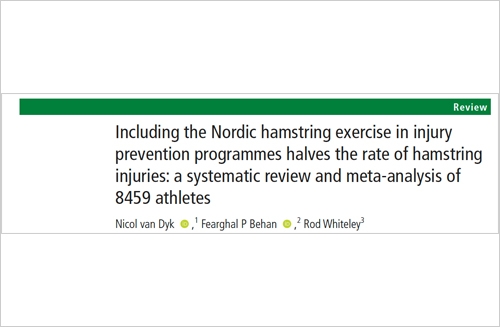Including the Nordic hamstring exercise in injury prevention programmes halves the rate of hamstring injuries: a systematic review and meta-analysis of 8459 athletes
Review Date:
03 December 2020
Review Group:
Mr Patrick Carton, Consultant Orthopaedic Surgeon, The Hip and Groin Clinic
Mr David Filan, Senior Research Assistant, UPMC Whitfield
Dr Karen Mullins, Research Assistant, UPMC Whitfield
Mr Derek O’Neill, Senior Physiotherapist, UPMC Whitfield
Dr Dualtach Mac Colgain, Sports Medicine Doctor, UPMC Whitfield
Dr Michael Hanlon, Lecturer, Waterford Institute of Technology
Mr Joey O’Brien, Strength & Conditioning Coach, WIT Arena
This paper is a systematic review, which by design pools together published studies to give a combined review and summary of the available literature relevant to a particular health-related issue in addition to a graphical representation of the results presented in the form of a meta-analysis.
Research Question:
The research question “Does the Nordic hamstring exercise (NHE) prevent hamstring injuries when included as part of an injury prevention intervention?” is clearly focused for the reader with respect to the intervention (Nordic hamstring exercise) and outcome measure (prevention of hamstring injuries) but is not clear on the specific population with which this review is evaluating. The authors however do detail this within the eligibility criteria in the abstract (“any athletes participating in any sporting activity”), adhering to the PICO framework
Methodology:
The overall consensus was that the authors have attempted to obtain as many papers and data available for compilation in this systematic review through searching multiple different electronic databases in addition to performing a cross-check from the reference lists of relevant papers. Considering this review is a therapy-based intervention the Cochrane Controlled Trials Registry would also have been a useful database for the authors to search which would have increased the validity of the search with respect to avoiding publication bias. However, the authors do report no language, gender, age, or time limits were applied which helps to minimise any publication biases.
The authors search strategy also appropriately includes both MeSH terms as well as keywords and they have supplied, as a supplementary file, details from the Medline search
Appropriately, 2 investigators performed the initial search with a third facilitating group consensus when disagreements were identified.
Flow chart: Although the authors appropriately followed the PRISMA guidelines for screening and ultimately including studies relevant to this question, the reasons for excluding any papers (beyond removing duplicate studies) were not provided, which would have further clarified the exclusion process.
Level of agreement (such as the kappa statistic) however between reviewers was not reported in this study. Providing this information would aid in confirming the validity of the review, as large areas of disagreement (if and when present) would affect any overall review result/conclusion.
Risk of bias was evaluated via authors judgement and through use of a funnel plot
Results
Within the included studies, there was large variation in the administration of the training protocol. This may be due to the inclusion criteria within this systematic review being so broad, i.e. opening it up to all genders, all sports, all ages and all levels of competition. Execution of the Nordic exercise is largely dictated by these factors. Although the overall result of this review favours the use of Nordics and further that “clinicians are encouraged to include the NHE in their prevention programmes” this review does not provide a gauge of the optimum and appropriate frequency or intensity of this exercise for the athlete in routine clinical practice, in order to reduce injury by 50%, which stems from the variation across the studies included. The authors of this review however do acknowledge this point in the limitations section (“It is not clear what the ideal prescription of the exercise is..”).
Of the included studies (15), five did not report the level of compliance with the intervention under investigation with a further 4 reporting compliance <50%. With such low compliance or failure to report compliance in 60% of the studies included in this review makes it difficult to be assured that any differences were solely due to the Nordic hamstring exercise.
A positive however of this study in spite of the low compliance rate within groups there is still an overall risk reduction of 50%. The authors do perform sensitivity analysis by removing potentially bias studies and assessing what effect this has on the risk ratio, which still favours the Nordic programme.
What is not included in the analysis is an evaluation of any benefits of the NHE prevention programme if those studies of non-compliance was excluded. By reviewing Figure 4, there are 3 studies (Amason 2007, Engebretsen 2008 and Gabbe 2006) which favour usual exercises over Nordics however these studies report high levels of non-compliance. In contrast, the Peterson study which is one of the more significant studies toward the Nordic programme being effective had a large sample size and a 90% compliance.
The Nordic programme did not reduce prevalence of hamstring injuries in female athletes.
Hamstring injuries do still occur irrespective of whether Nordic programme is introduced or not, albeit to a lesser extent than without its inclusion.
Review Group Summary:
- The conclusions made within this systematic review appear to be well supported by the results.
- The findings from this study are in agreement with previous systematic reviews on the same topic







